oil SKODA FABIA 2010 2.G / 5J User Guide
[x] Cancel search | Manufacturer: SKODA, Model Year: 2010, Model line: FABIA, Model: SKODA FABIA 2010 2.G / 5JPages: 244, PDF Size: 29.53 MB
Page 149 of 244
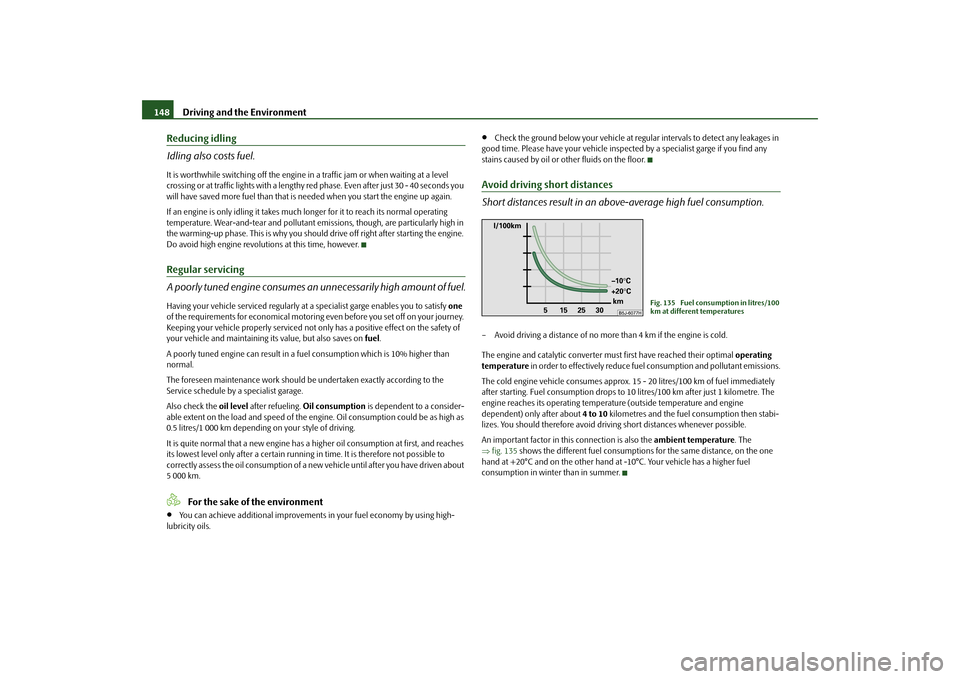
Driving and the Environment
148
Reducing idling Idling also costs fuel.It is worthwhile switching off the engine in
a traffic jam or when waiting at a level
crossing or at traffic lights with a lengthy red phase. Even after just 30 - 40 seconds you will have saved more fuel th
an that is needed when you start the engine up again.
If an engine is only idling it takes much
longer for it to reach its normal operating
temperature. Wear-and-tear and pollutant emis
sions, though, are particularly high in
the warming-up phase. This is why you should drive off right after starting the engine. Do avoid high engine revolu
tions at this time, however.
Regular servicing A poorly tuned engine consumes an unnecessarily high amount of fuel.Having your vehicle serviced regularly at a specialist garge enables you to satisfy
one
of the requirements for economical motoring even before you set off on your journey. Keeping your vehicle properly serviced not on
ly has a positive effect on the safety of
your vehicle and maintaining its value, but also saves on
fuel
.
A poorly tuned engine can result in a fu
el consumption which
is 10% higher than
normal. The foreseen maintenance work should be
undertaken exactly according to the
Service schedule by a specialist garage. Also check the
oil level
after refueling.
Oil consumption
is dependent to a consider-
able extent on the load and speed of the en
gine. Oil consumption co
uld be as high as
0.5 litres/1 000 km depending on your style of driving. It is quite normal that a new engine has a
higher oil consumption
at first, and reaches
its lowest level only after a certain running in time. It is therefore not possible to correctly assess the oil consumption of a new
vehicle until after yo
u have driven about
5 000 km.
For the sake of the environment
You can achieve additional
improvements in your fuel economy by using high-
lubricity oils.
Check the ground below your vehicle at regular intervals to detect any leakages in
good time. Please have your vehicle inspec
ted by a specialist garge if you find any
stains caused by oil or other fluids on the floor.Avoid driving short distances Short distances result in an above-average high fuel consumption.– Avoid driving a distance of no more
than 4 km if th
e engine is cold.
The engine and catalytic converter mu
st first have reached their optimal
operating
temperature
in order to effectively reduce fuel consumption and pollutant emissions.
The cold engine vehicle cons
umes approx. 15 - 20 litres/100 km of fuel immediately
after starting. Fuel co
nsumption drops to 10 litres/100
km after just 1 kilometre. The
engine reaches its operating temperat
ure (outside temperature and engine
dependent) only after about
4 to 10
kilometres and the fuel consumption then stabi-
lizes. You should therefore avoid driving short distances whenever possible. An important factor in this connection is also the
ambient temperature
. The
fig. 135
shows the different fuel consumptions for the same distance, on the one
hand at +20°C and on the other hand at
-10°C. Your vehicle has a higher fuel
consumption in winter than in summer.
Fig. 135 Fuel consumption in litres/100 km at different temperatures
s3j8.a.book Page 148 Tuesday, April 20, 2010 1:10 PM
Page 151 of 244
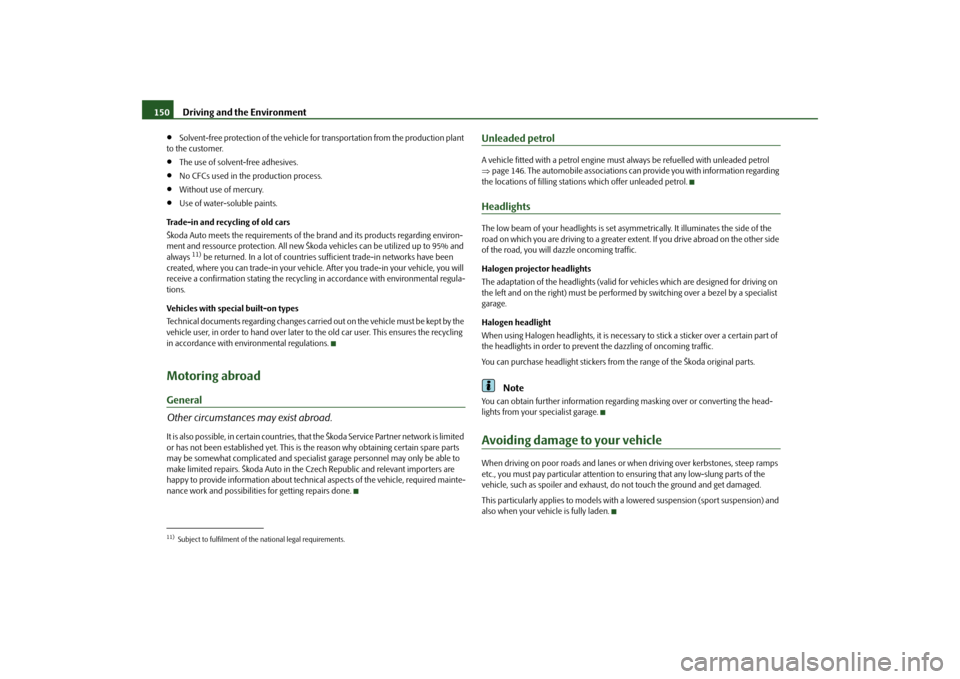
Driving and the Environment
150
Solvent-free protection of the vehicle for
transportation from the production plant
to the customer.
The use of solvent-free adhesives.
No CFCs used in the production process.
Without use of mercury.
Use of water-soluble paints.
Trade-in and recycling of old cars Škoda Auto meets the requirements of the brand and its products regarding environ- ment and ressource protection. All new Škoda
vehicles can be utilized up to 95% and
always
11) be returned. In a lot of countries sufficient trade-in networks have been
created, where you can trade-in your vehicle.
After you trade-in your vehicle, you will
receive a confirmation stating the recycling
in accordance with environmental regula-
tions. Vehicles with special built-on types Technical documents regarding changes carried
out on the vehicle must be kept by the
vehicle user, in order to hand over later to the old car user. This ensures the recycling in accordance with en
vironmental regulations.
Motoring abroadGeneral Other circumstances may exist abroad.It is also possible, in certai
n countries, that the
Škoda Service Partner network is limited
or has not been established yet. This is
the reason why obtaining certain spare parts
may be somewhat complicated and specialist
garage personnel may only be able to
make limited repairs. Škoda
Auto in the Czech Republic and relevant importers are
happy to provide information
about technical aspects of the vehicle, required mainte-
nance work and possibilities for getting repairs done.
Unleaded petrolA vehicle fitted with a petrol engine must
always be refuelled
with unleaded petrol
page 146. The automobile associations can provide you with information regarding the locations of filling stations which offer unleaded petrol.HeadlightsThe low beam of your headligh
ts is set asymmetrically. It illuminates the side of the
road on which you are driving to a greater ex
tent. If you drive abroad on the other side
of the road, you will da
zzle oncoming traffic.
Halogen projector headlights The adaptation of the headlights (valid for vehicles which are designed for driving on the left and on the right) must be performe
d by switching over a bezel by a specialist
garage. Halogen headlight When using Halogen headlights, it is necessary to stick a sticker over a certain part of the headlights in order to prevent the dazzling of oncoming traffic. You can purchase headlight stickers from
the range of the Škoda original parts.
Note
You can obtain further information regardin
g masking over or converting the head-
lights from your specialist garage.Avoiding damage to your vehicleWhen driving on poor roads and lanes or when driving over kerbstones, steep ramps etc., you must pay particular attention to
ensuring that any low-slung parts of the
vehicle, such as spoiler and exhaust,
do not touch the ground and get damaged.
This particularly applies to models with a lowered suspension (sport suspension) and also when your vehicle is fully laden.
11)Subject to fulfilment of the national legal requirements.s3j8.a.book Page 150 Tuesday, April 20, 2010 1:10 PM
Page 157 of 244
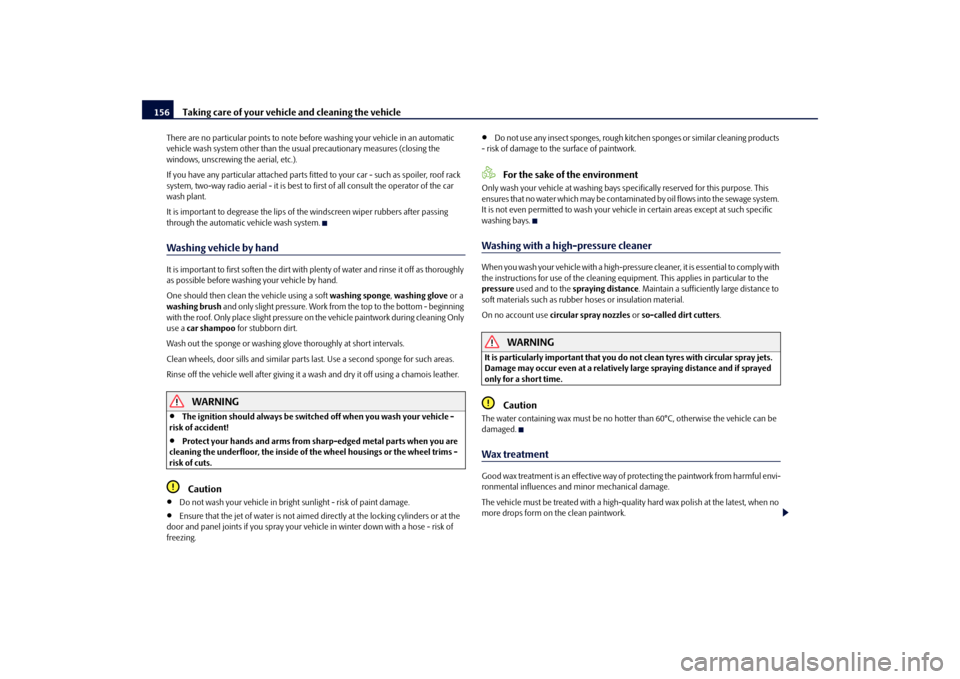
Taking care of your vehicle and cleaning the vehicle
156
There are no particular points to note be
fore washing your vehicle in an automatic
vehicle wash system other than the usua
l precautionary measures (closing the
windows, unscrewing the aerial, etc.). If you have any particular atta
ched parts fitted to your car
- such as spoiler, roof rack
system, two-way radio aerial - it is best to first of all consult the operator of the car wash plant. It is important to degrease
the lips of the windscreen
wiper rubbers after passing
through the automatic
vehicle wash system.
Washing vehicle by handIt is important to first soften the dirt with
plenty of water and rinse it off as thoroughly
as possible before washin
g your vehicle by hand.
One should then clean the vehicle using a soft
washing sponge
, washing glove
or a
washing brush
and only slight pressure. Work from
the top to the bottom - beginning
with the roof. Only place slight pressure on
the vehicle paintwork during cleaning Only
use a
car shampoo
for stubborn dirt.
Wash out the sponge or washing glove thoroughly at short intervals.Clean wheels, door sills and similar parts last. Use a second sponge for such areas.Rinse off the vehicle well after giving it a wash and dry it off using a chamois leather.
WARNING
The ignition should always be switched off when you wash your vehicle -
risk of accident!
Protect your hands and arms from sharp-edged metal parts when you are
cleaning the underfloor, the inside of
the wheel housings or
the wheel trims -
risk of cuts.
Caution
Do not wash your vehicle in bright
sunlight - risk of paint damage.
Ensure that the jet of water is not aimed di
rectly at the locking cylinders or at the
door and panel joints if you spray your vehi
cle in winter down with a hose - risk of
freezing.
Do not use any insect sponges, rough kitc
hen sponges or similar cleaning products
- risk of damage to the surface of paintwork.
For the sake of the environment
Only wash your vehicle at wa
shing bays specifically reserved for this purpose. This
ensures that no water which may be contaminated by oil flows into the sewage system. It is not even permitted to wash your vehicl
e in certain areas except at such specific
washing bays.Washing with a high-pressure cleanerWhen you wash your vehicle with a high-press
ure cleaner, it is essential to comply with
the instructions for use of the cleaning equi
pment. This applies in particular to the
pressure
used and to the
spraying distance
. Maintain a sufficiently large distance to
soft materials such as rubber hoses or insulation material. On no account use
circular spray nozzles
or so-called dirt cutters
.
WARNING
It is particularly important that you do not clean tyres with circular spray jets. Damage may occur even at a relatively la
rge spraying distance and if sprayed
only for a short time.
Caution
The water containing wax must be no hotter
than 60°C, otherwise the vehicle can be
damaged.Wax treatmentGood wax treatment is an effective way of
protecting the paintwork from harmful envi-
ronmental influences and
minor mechanical damage.
The vehicle must be treated with a high-quali
ty hard wax polish at the latest, when no
more drops form on the clean paintwork.
s3j8.a.book Page 156 Tuesday, April 20, 2010 1:10 PM
Page 158 of 244
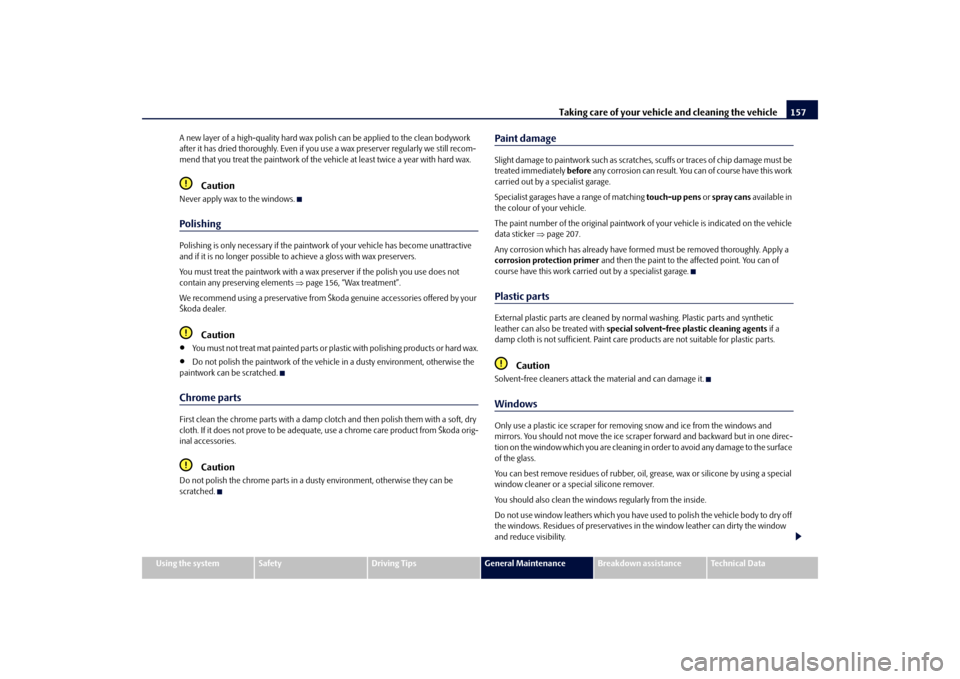
Taking care of your vehicle and cleaning the vehicle
157
Using the system
Safety
Driving Tips
General Maintenance
Breakdown assistance
Technical Data
A new layer of a high-quality
hard wax polish can be applied to the clean bodywork
after it has dried thoroughly. Even if you use a wax preserver regularly we still recom- mend that you treat the paintwork of the ve
hicle at least twice a year with hard wax.
Caution
Never apply wax to the windows.PolishingPolishing is only necessary if the paintwor
k of your vehicle has become unattractive
and if it is no longer possible to
achieve a gloss with wax preservers.
You must treat the paintwork with a wax pr
eserver if the polish you use does not
contain any preserving elements
page 156, “Wax treatment”.
We recommend using a preserva
tive from Škoda genuine accessories offered by your
Škoda dealer.
Caution
You must not treat mat painted parts or plas
tic with polishing products or hard wax.
Do not polish the paintwork of the vehicl
e in a dusty environment, otherwise the
paintwork can be scratched.Chrome partsFirst clean the chrome parts with a damp clot
ch and then polish them with a soft, dry
cloth. If it does not prove
to be adequate, use a chrome
care product from Škoda orig-
inal accessories.
Caution
Do not polish the chrome parts in a du
sty environment, otherwise they can be
scratched.
Paint damageSlight damage to paintwork such as scratches, scuffs or traces of chip damage must be treated immediately
before
any corrosion can result. You ca
n of course have this work
carried out by a specialist garage. Specialist garages have a range of matching
touch-up pens
or spray cans
available in
the colour of your vehicle. The paint number of the original paintwork of
your vehicle is indi
cated on the vehicle
data sticker
page 207.
Any corrosion which has already have formed must be removed thoroughly. Apply a corrosion protection primer
and then the paint to the affected point. You can of
course have this work carried
out by a specialist garage.
Plastic partsExternal plastic parts are cleaned by norm
al washing. Plastic parts and synthetic
leather can also be treated with
special solvent-free plastic cleaning agents
if a
damp cloth is not sufficient. Paint care pr
oducts are not suitable for plastic parts.
Caution
Solvent-free cleaners attack th
e material and can damage it.
WindowsOnly use a plastic ice scra
per for removing snow and ice from the windows and
mirrors. You should not move the ice scraper forward and backward but in one direc-tion on the window which you
are cleaning in order to avoid any damage to the surface
of the glass. You can best remove residues of rubber, oil,
grease, wax or silicone by using a special
window cleaner or a special silicone remover. You should also clean the windows regularly from the inside.Do not use window leathers which you have us
ed to polish the vehicle body to dry off
the windows. Residues of preservatives in the window leather can dirty the window and reduce visibility.
s3j8.a.book Page 157 Tuesday, April 20, 2010 1:10 PM
Page 159 of 244
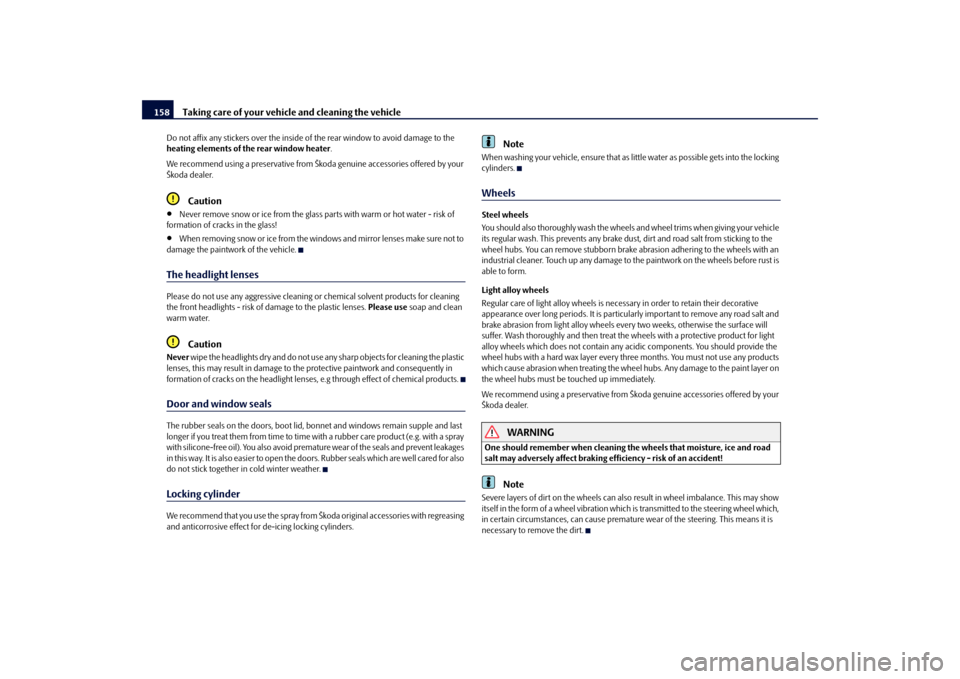
Taking care of your vehicle and cleaning the vehicle
158
Do not affix any stickers over the inside of
the rear window to avoid damage to the
heating elements of the rear window heater
.
We recommend using a preserva
tive from Škoda genuine accessories offered by your
Škoda dealer.
Caution
Never remove snow or ice from the glass pa
rts with warm or hot water - risk of
formation of cracks in the glass!
When removing snow or ice from the windows and mirror lenses make sure not to
damage the paintwork of the vehicle.The headlight lensesPlease do not use any aggressi
ve cleaning or chemical so
lvent products for cleaning
the front headlights - risk of
damage to the
plastic lenses.
Please use
soap and clean
warm water.
Caution
Never
wipe the headlights dry and do not use any sharp objects for cleaning the plastic
lenses, this may result in damage to the
protective paintwork and consequently in
formation of cracks on the headlight lenses, e.g through effect of chemical products.Door and window sealsThe rubber seals on the doors, boot lid,
bonnet and windows remain supple and last
longer if you treat them from time to time with a rubber care product (e.g. with a spray with silicone-free oil). You also avoid premature wear of the seals and prevent leakages in this way. It is also easier to open the doors. Rubber seals which are well cared for also do not stick together in cold winter weather.Locking cylinderWe recommend that you use the spray from Škoda original accessories with regreasing and anticorrosive effect for de-icing locking cylinders.
Note
When washing your vehicle, ensure that as
little water as possible gets into the locking
cylinders.WheelsSteel wheels You should also thoroughly wash the wheels
and wheel trims when giving your vehicle
its regular wash. This prevents any brake dust, dirt and road salt from sticking to the wheel hubs. You can remove stubborn brake
abrasion adhering to the wheels with an
industrial cleaner. Touch up
any damage to the paintwork on the wheels before rust is
able to form. Light alloy wheels Regular care of light alloy wh
eels is necessary in order to retain their decorative
appearance over long periods. It is particul
arly important to remove any road salt and
brake abrasion from light alloy wheels every two weeks, otherwise the surface will suffer. Wash thoroughly and then treat the wheels with a protective product for light alloy wheels which does not
contain any acidic componen
ts. You should provide the
wheel hubs with a hard wax layer every thre
e months. You must not use any products
which cause abrasion when treating the wheel hubs. Any damage to the paint layer on the wheel hubs must be touched up immediately. We recommend using a preservative from Šk
oda genuine accessories offered by your
Škoda dealer.
WARNING
One should remember when cleaning th
e wheels that moisture, ice and road
salt may adversely affect braking ef
ficiency - risk of an accident!
Note
Severe layers of dirt on the wheels can also
result in wheel imbalance. This may show
itself in the form of a wheel vibration which
is transmitted to the steering wheel which,
in certain circumstances, can
cause premature wear of the
steering. This means it is
necessary to remove the dirt.
s3j8.a.book Page 158 Tuesday, April 20, 2010 1:10 PM
Page 160 of 244
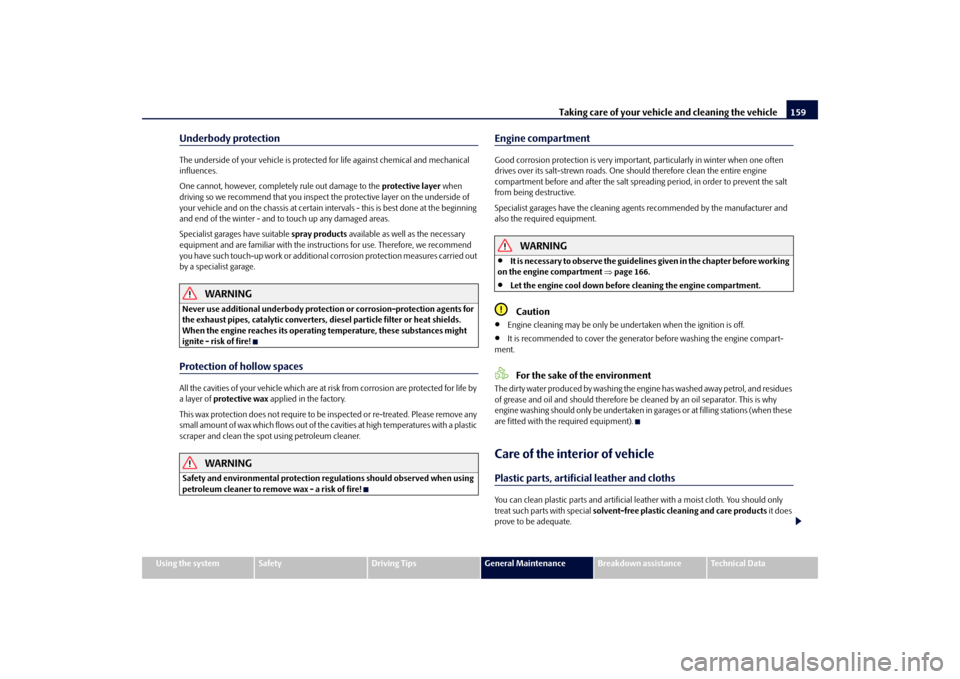
Taking care of your vehicle and cleaning the vehicle
159
Using the system
Safety
Driving Tips
General Maintenance
Breakdown assistance
Technical Data
Underbody protectionThe underside of your vehicle is protected for life against chemical and mechanical influences. One cannot, however, complete
ly rule out damage to the
protective layer
when
driving so we recommend that you inspect the protective layer on the underside of your vehicle and on the
chassis at certain intervals - this is best done at the beginning
and end of the winter - and to touch up any damaged areas. Specialist garages have suitable
spray products
available as well
as the necessary
equipment and are familiar with the instructions for use. Therefore, we recommend you have such touch-up work or additional
corrosion protection measures carried out
by a specialist garage.
WARNING
Never use additional underbody protection or corrosion-protection agents for the exhaust pipes, catalytic converters, di
esel particle filter or heat shields.
When the engine reaches its operating
temperature, these substances might
ignite - risk of fire!Protection of hollow spacesAll the cavities of your vehicle which are at risk from corrosion are protected for life by a layer of
protective wax
applied in the factory.
This wax protection does not require to be inspected or re-treated. Please remove any small amount of wax which flows out of the cavities at high temperatures with a plastic scraper and clean the spot using petroleum cleaner.
WARNING
Safety and environmental pr
otection regulations should observed when using
petroleum cleaner to remove wax - a risk of fire!
Engine compartmentGood corrosion protection is very importan
t, particularly in winter when one often
drives over its salt-strewn roads. One should therefore clean the entire engine compartment before and after the salt spread
ing period, in order to prevent the salt
from being destructive. Specialist garages have the cleaning agen
ts recommended by the manufacturer and
also the required equipment.
WARNING
It is necessary to observ
e the guidelines given in the chapter before working
on the engine compartment
page 166.
Let the engine cool down before cleaning the engine compartment.Caution
Engine cleaning may be only be un
dertaken when the ignition is off.
It is recommended to cover the generator before washing the engine compart-
ment.
For the sake of the environment
The dirty water produced by washing the engine has washed away petrol, and residues of grease and oil and should therefore be
cleaned by an oil separator. This is why
engine washing should only be undertaken in garages or at filling stations (when these are fitted with the required equipment).Care of the interior of vehiclePlastic parts, artificial leather and clothsYou can clean plastic parts and artificial le
ather with a moist cloth. You should only
treat such parts with special
solvent-free plastic cleaning and care products
it does
prove to be adequate.
s3j8.a.book Page 159 Tuesday, April 20, 2010 1:10 PM
Page 161 of 244
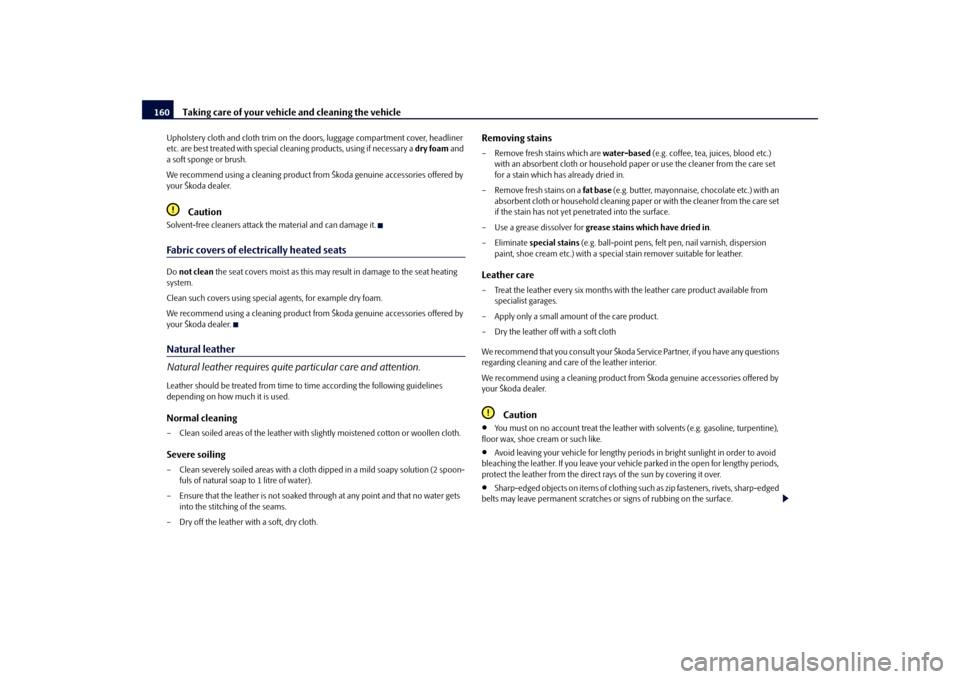
Taking care of your vehicle and cleaning the vehicle
160
Upholstery cloth and cloth trim on the d
oors, luggage compartment cover, headliner
etc. are best treated with special cleaning products, using if necessary a
dry foam
and
a soft sponge or brush. We recommend using a cleaning product from Škoda genuine accessories offered by your Škoda dealer.
Caution
Solvent-free cleaners attack th
e material and can damage it.
Fabric covers of elec
trically heated seats
Do
not clean
the seat covers moist as this may re
sult in damage to the seat heating
system. Clean such covers using specia
l agents, for example dry foam.
We recommend using a cleaning product from Škoda genuine accessories offered by your Škoda dealer.Natural leather Natural leather requires quite particular care and attention.Leather should be treated from time to time according the following guidelines depending on how much it is used.Normal cleaning– Clean soiled areas of the leather with
slightly moistened co
tton or woollen cloth.
Severe soiling– Clean severely soiled areas with a cloth
dipped in a mild soap
y solution (2 spoon-
fuls of natural soap to 1 litre of water).
– Ensure that the leather is not soaked through at any point and that no water gets
into the stitching of the seams.
– Dry off the leather with a soft, dry cloth.
Removing stains– Remove fresh stains which are
water-based
(e.g. coffee, tea, juices, blood etc.)
with an absorbent cloth or household pape
r or use the cleaner from the care set
for a stain which has already dried in.
– Remove fresh stains on a
fat base
(e.g. butter, mayonnaise, chocolate etc.) with an
absorbent cloth or household
cleaning paper or with the
cleaner from the care set
if the stain has not yet pe
netrated into the surface.
– Use a grease dissolver for
grease stains which have dried in
.
–Eliminate
special stains
(e.g. ball-point pens, felt pe
n, nail varnish, dispersion
paint, shoe cream etc.) with a special stain remover suitable for leather.
Leather care– Treat the leather every six months with
the leather care product available from
specialist garages.
– Apply only a small amount of the care product.– Dry the leather off with a soft cloth We recommend that you consult your Škoda Se
rvice Partner, if you have any questions
regarding cleaning and care of the leather interior. We recommend using a cleaning product fr
om Škoda genuine accessories offered by
your Škoda dealer.
Caution
You must on no account treat the leather wi
th solvents (e.g. gasoline, turpentine),
floor wax, shoe cream or such like.
Avoid leaving your vehicle for lengthy period
s in bright sunlight in order to avoid
bleaching the leather. If you
leave your vehicle parked in the open for lengthy periods,
protect the leather from the direct ra
ys of the sun by covering it over.
Sharp-edged objects on items of clothing su
ch as zip fasteners, rivets, sharp-edged
belts may leave permanent scratches or signs of rubbing on the surface.
s3j8.a.book Page 160 Tuesday, April 20, 2010 1:10 PM
Page 162 of 244
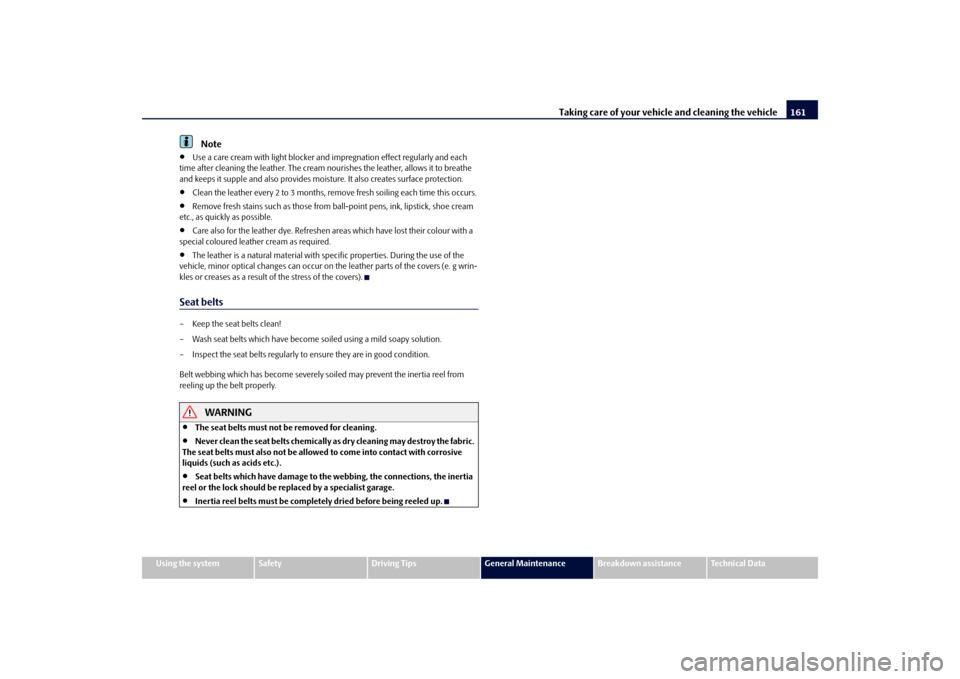
Taking care of your vehicle and cleaning the vehicle
161
Using the system
Safety
Driving Tips
General Maintenance
Breakdown assistance
Technical Data
Note
Use a care cream with light blocker and impregnation effect regularly and each
time after cleaning th
e leather. The cream nourishes the
leather, allows it to breathe
and keeps it supple and also provides moisture. It also creates surface protection.
Clean the leather every 2 to 3 months, remove fresh soiling each time this occurs.
Remove fresh stains such as those from
ball-point pens, ink, lipstick, shoe cream
etc., as quickly as possible.
Care also for the leather dye. Refreshen ar
eas which have lost their colour with a
special coloured leather cream as required.
The leather is a natural material with specific properties. During the use of the
vehicle, minor optical changes can occur on
the leather parts of the covers (e. g wrin-
kles or creases as a result
of the stress of the covers).
Seat belts– Keep the seat belts clean! – Wash seat belts which have become
soiled using a mild soapy solution.
– Inspect the seat belts regularly to
ensure they are in good condition.
Belt webbing which has become severely so
iled may prevent the inertia reel from
reeling up the belt properly.
WARNING
The seat belts must not be removed for cleaning.
Never clean the seat belts chemically as
dry cleaning may destroy the fabric.
The seat belts must also not be allowed to come into contact with corrosive liquids (such as acids etc.).
Seat belts which have damage to the
webbing, the connections, the inertia
reel or the lock should be re
placed by a specialist garage.
Inertia reel belts
must be completely dried before being reeled up.
s3j8.a.book Page 161 Tuesday, April 20, 2010 1:10 PM
Page 167 of 244
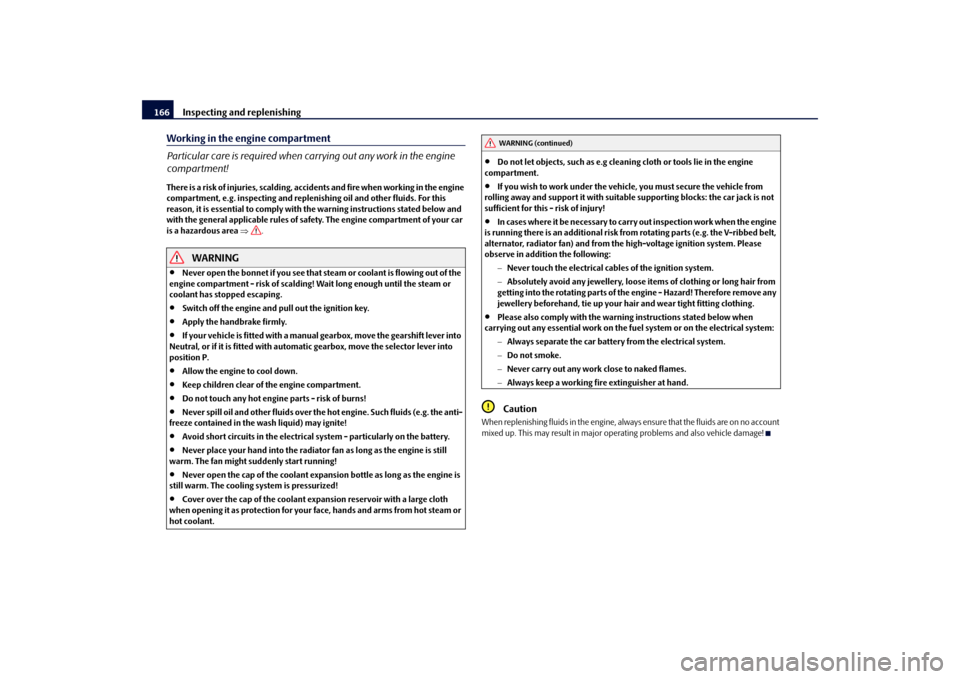
Inspecting and replenishing
166
Working in the engine compartment Particular care is required when carrying out any work in the engine compartment!There is a risk of injuries, scalding, acci
dents and fire when working in the engine
compartment, e.g. inspecting and replenishing oil and other fluids. For this reason, it is essential to comply with the warning instructions stated below and with the general applicable rules of safe
ty. The engine compartment of your car
is a hazardous area
.
WARNING
Never open the bonnet if
you see that steam or coolant is flowing out of the
engine compartment - risk of scalding!
Wait long enough until the steam or
coolant has stopped escaping.
Switch off the engine and pull out the ignition key.
Apply the handbrake firmly.
If your vehicle is fitted with a manual
gearbox, move the gearshift lever into
Neutral, or if it is fitted with automatic gearbox, move the selector lever into position P.
Allow the engine to cool down.
Keep children clear of the engine compartment.
Do not touch any hot engine parts - risk of burns!
Never spill oil and other fluids over the hot engine. Such fluids (e.g. the anti-
freeze contained in the wash liquid) may ignite!
Avoid short circuits in the electrical system - particularly on the battery.
Never place your hand into the radiator fan as long as the engine is still
warm. The fan might suddenly start running!
Never open the cap of the coolant expans
ion bottle as long as the engine is
still warm. The cooling
system is pressurized!
Cover over the cap of the coolant expansion reservoir with a large cloth
when opening it as protection for your
face, hands and arms from hot steam or
hot coolant.
Do not let objects, such as e.g cleaning cloth or tools lie in the engine
compartment.
If you wish to work under the vehicl
e, you must secure the vehicle from
rolling away and support it with suitable supporting blocks: the car jack is not sufficient for this - risk of injury!
In cases where it be necessary to carry out inspection work when the engine
is running there is an additional risk fr
om rotating parts (e.g. the V-ribbed belt,
alternator, radiator fan) and from the high-voltage ignition system. Please observe in addition the following:
Never touch the electrical cabl
es of the ignition system.
Absolutely avoid any jewellery, loose it
ems of clothing or long hair from
getting into the rotating parts of the
engine - Hazard! Therefore remove any
jewellery beforehand, tie up your hair and wear tight fitting clothing.
Please also comply with the warnin
g instructions st
ated below when
carrying out any essential work on the fu
el system or on th
e electrical system:
Always separate the car battery from the electrical system. Do not smoke. Never carry out any work close to naked flames. Always keep a working fire
extinguisher at hand.
Caution
When replenishing fluids in the engine, always
ensure that the fluids are on no account
mixed up. This may result in major oper
ating problems and also vehicle damage!
WARNING (continued)
s3j8.a.book Page 166 Tuesday, April 20, 2010 1:10 PM
Page 168 of 244
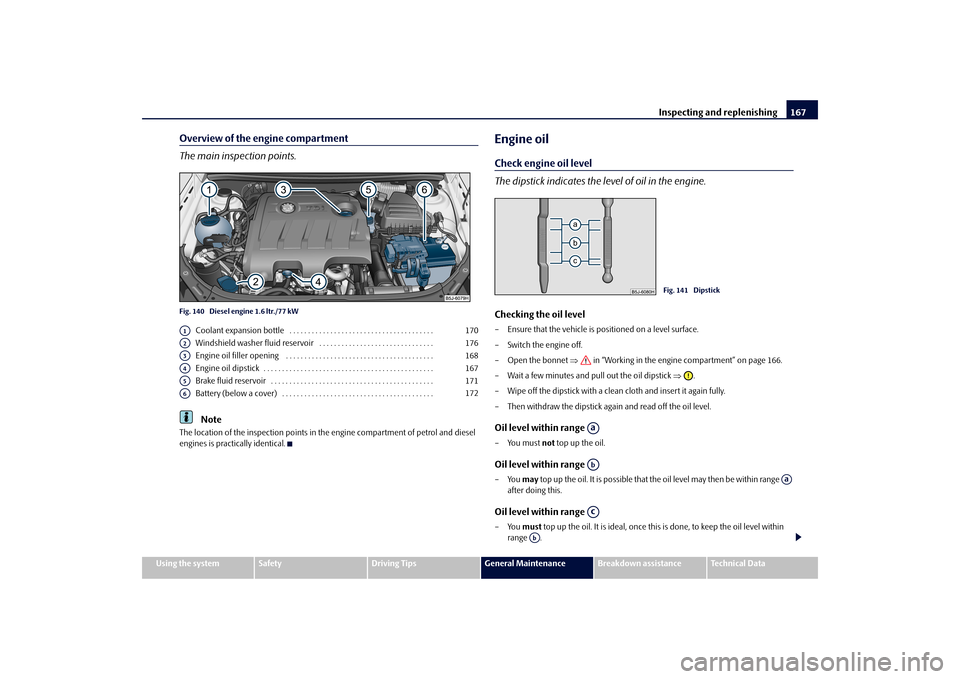
Inspecting and replenishing
167
Using the system
Safety
Driving Tips
General Maintenance
Breakdown assistance
Technical Data
Overview of the engine compartment The main inspection points.Fig. 140 Diesel engine 1.6 ltr./77 kW
Coolant expansion bottle . . . . . . . . . . . . . . . . . . . . . . . . . . . . . . . . . . . . . . . Windshield washer fluid reservoir . . . . . . . . . . . . . . . . . . . . . . . . . . . . . . . Engine oil filler opening . . . . . . . . . . . . . . . . . . . . . . . . . . . . . . . . . . . . . . . .Engine oil dipstick . . . . . . . . . . . . . . . . . . . . . . . . . . . . . . . . . . . . . . . . . . . . . . Brake fluid reservoir . . . . . . . . . . . . . . . . . . . . . . . . . . . . . . . . . . . . . . . . . . . . Battery (below a cover) . . . . . . . . . . . . . . . . . . . . . . . . . . . . . . . . . . . . . . . . .Note
The location of the inspection points in th
e engine compartment of petrol and diesel
engines is practically identical.
Engine oilCheck engine oil level The dipstick indicates the le
vel of oil in the engine.
Checking the oil level– Ensure that the vehicle is po
sitioned on a level surface.
– Switch the engine off.– Open the bonnet
in “Working in the engine compartment” on page 166.
– Wait a few minutes and pull out the oil dipstick
.
– Wipe off the dipstick with a clea
n cloth and insert it again fully.
– Then withdraw the dipstick again and read off the oil level.Oil level within range –You must
not
top up the oil.
Oil level within range –You
may
top up the oil. It is possible that the oil level may then be within range
after doing this.
Oil level within range –You
must
top up the oil. It is ideal, once this
is done, to keep the oil level within
range .
A1
170
A2
176
A3
168
A4
167
A5
171
A6
172
Fig. 141 Dipstick
AaAb
Aa
Ac
Ab
s3j8.a.book Page 167 Tuesday, April 20, 2010 1:10 PM